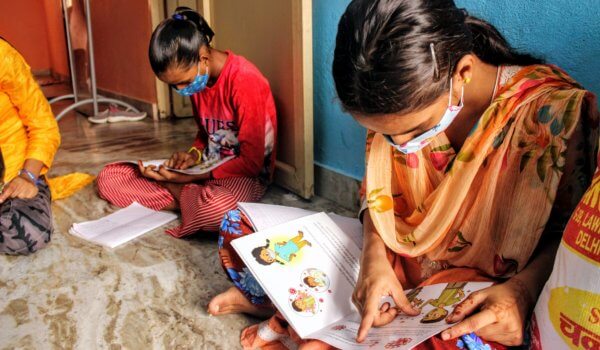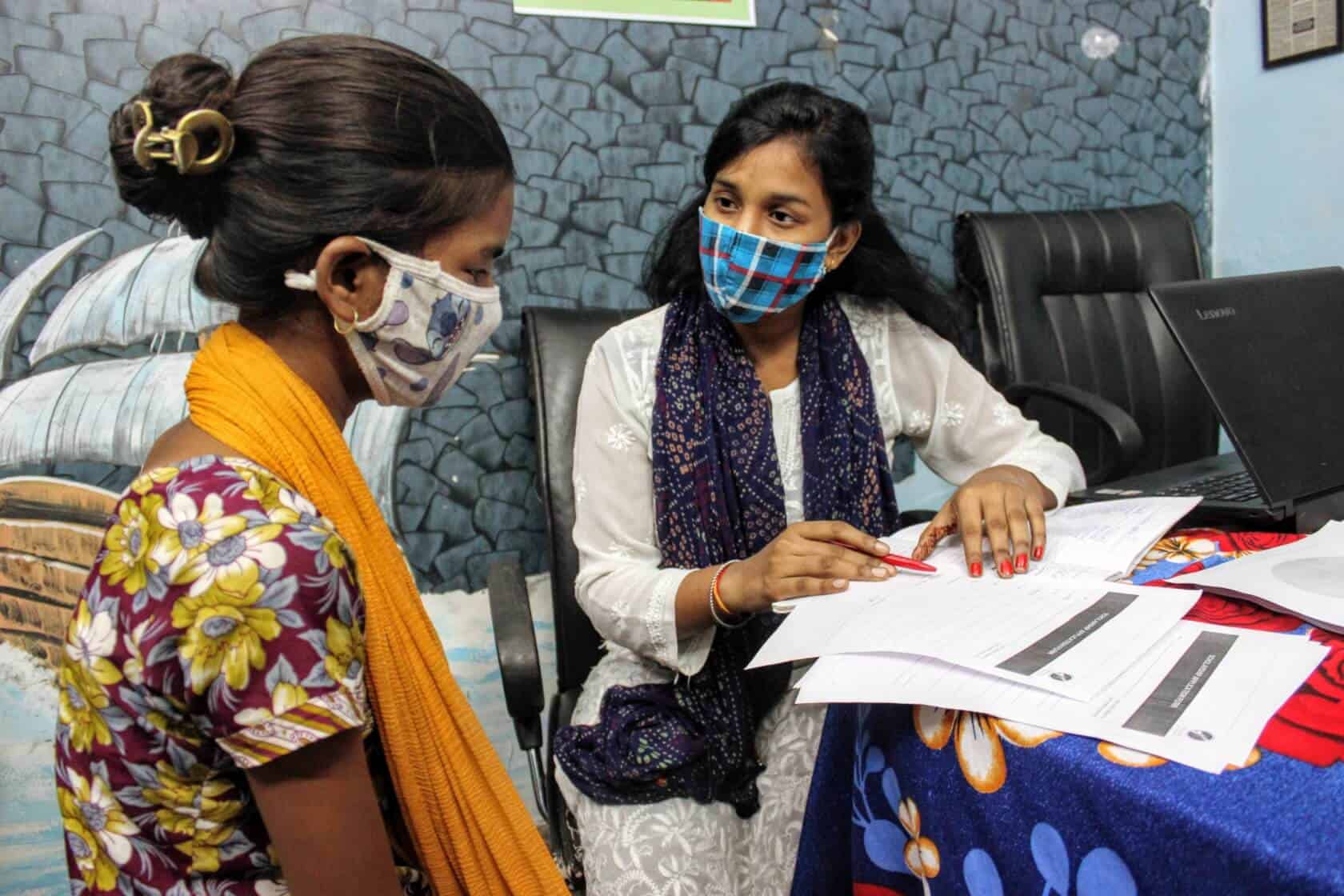From just one room to one of Dehli's most important NGOs for girls, this is the incredible story of Protsahan India Foundation.
What started as a one room creative arts and design school in one of the darkest slums of India, is now a wonderful organisation with crucial impacts on empowering girls from difficult backgrounds of poverty, violence and abuse to access quality education, healthcare and gender justice.
Let’s look at the amazing journey of the Protsahan India Foundation and its founder, Sonal Kapoor.
Protsahan India Foundation empowers children and stakeholders to create a future full of possibilities where children and adolescent girls, both survivors and those at risk of abuse, find an environment conducive to their safety, healing and growth using art and technology.
Being the Change You Want to See
While on a film shoot in 2010, as a 24-year-old, Kapoor met a young woman in an impoverished urban slum who had six daughters and was pregnant with her seventh child. On being asked about her circumstances, the woman narrated in a matter-of-fact way that she was ready to kill her new-born if it was a girl once again.
She also spoke of sending one of her eight-year-old daughters to a brothel for sex work so that she could feed the rest of her family with the money that this child brings in by selling her body.

Like many of us would be, Kapoor was devastated to hear this. However, unlike many of us, in that very moment, Kapoor raised her voice and became the change she wanted to see in the world.
Within the same hour she listened to this story, Kapoor had the idea of starting a unique creative and trauma-informed child-friendly space in the community that had taken shape in her mind which envisioned reaching the most vulnerable girls at the last mile with equality of access to resources and opportunities.
“Three weeks later, after a small feasibility study in the area, Protsahan India Foundation started as a one room creative arts and design school in one of the darkest slums of the country, in the heart of the capital city, New Delhi to rescue that one child, and many more like her from systemic, intergenerational poverty, violence and abuse,” she recalls.
Every Girl Pursues Her Potential
Since then, Protsahan has rescued 928 girls and successfully mainstreamed them into formal schools, and reaches 72,000 girls annually through its programs panning education, nutrition, menstrual hygiene, arts for gender justice and healing and child protection in India.
In this exclusive interview with Youth Time, Kapoor shares more aspects of their work, and describes the decade-long journey of your organization.
“The core non-negotiables of quality education, healthcare and gender justice – should reach every adolescent girl and every vulnerable child irrespective of where that child comes from. Protsahan envisions a world where every survivor or at-risk girl has the knowledge, skills and agency to pursue her aspirations and explore her fullest potential.”,
In the coming decades, Protsahan India Foundation envisions impacting the lives of one million at-risk children through strategic on-ground direct impact and collaborations.
Celebrating Achievements and Tackling Challenges
Once you visit Protsahan India Foundation’s website, you will see impressive numbers illustrating its achievements.
The way to success is rarely paved without challenges.
So, in this part, Kapoor dwells more on upon the key challenges in their way to success, which are as follows:
- Long term committed funding from CSRs towards rights based programming projects which are actually most sustainable – remains a challenge.
- COVID-19 induced lockdowns brought in huge learning gaps because of school closures and child protection emergencies only exacerbated.
- Capacity building of the frontline workers and child protection officers along with learning and development at the organization level, academic tuition support and scholarships, admin costs of running the organization unto its full potential also remain a few under-funded areas.
- Most of the children are first generation learners, and majorly lack support structures and adult supervision at home, leading to non-safe digital pathways to inclusions, and larger gestation times for results to trickle in program outcomes.
- Protsahan’s flagship girl champion programming requires mind-set changes and cannot be drafted as a one-year CSR project. These are long term programs that need invested funders as much invested on ground teams. One without the other will not lead to authentic impact.
Despite these obstacles, the organisation has many running programs improving the lives of children and young girls.
Let’s look at its unique HEART Model – an empathy-based model developed by Protsahan India Foundation in 2010 of working with children and adolescents at-risk or who have experienced traumatic events.
“Protsahan strives to work together with the marginalised communities of children to strengthen all parts of child protection systems with a focus on both – prevention and healing, inclusive of community-based support and justice mechanisms, to operate in the best interests of the child. If not rights based frameworks, needs based frameworks are seldom self-sustaining,” Kapoor reminds us.
Protsahan strives to break the intergenerational cycle of childhood abuse and poverty with Holistic Healing (of Abuse & Trauma), Education, Art interventions for Life Skills Training, Recovery, and Technology.
The creative power of Technology, Photography, Filmmaking and Cinema, Design, Performing Arts, and Meditations is used in a Protsahan classroom to heal and transform broken childhoods of adolescent girls who are survivors or are at high risk of abuse.
Delaying Child Marriages and First Pregnancies
Another crucial contribution of Protsahan is its continued education and employability enhancing life skills of young girls so that they do not fall into child marriages.
This project is at the very core of Protsahan’s HEART Model approach of working with ‘invisible forgotten adolescents’ at the last rung of the social ladder.
“We believe that art has the power to heal, inspire, provoke, challenge, and offer hope. Arts for Gender Justice at grassroots creates awareness to bring gender equality and social justice by cultivating artistic expression to address issues affecting girls and their communities and to challenge stereotypes surrounding them,” she says.
Protsahan’s Effective Covid-19 Response
Briefing us on the impact of COVID-19 pandemic in children’s rights, she recalls that in India it is estimated, according to the Lancet Study, that 89,066 children lost one parent to COVID-19.
The numbers rise to 119,170 of primary caregivers, if custodial grandparents are included. For India, the rapid increase in COVID-19-associated deaths from February to April 2021, was associated with an 8·5-times increase in the number of children losing caregivers in April (43,139 more children than March total) compared with March (5091 more children than February total).
As the nation continues to grapple with the deadly coronavirus second wave amid vaccination drives, it has left a devastating toll on human lives and minds.
“Perhaps, the worst part of the unfolding tragedy has been its impact on vulnerable populations, including children, who are neither physically nor mentally disposed to battle the virus and it is ensuing systemic education, nutritional and healthcare complexities,” she elaborates.
In response to this challenge, Protsahan India Foundation is continuously investing in local girl leaders through a comprehensive leadership framework that creates not just employability enhancement opportunities for the girls themselves- but also stronger and sustainable communities by encouraging COVID-19 vaccination drives and tackling vaccination hesitancy in deep impoverished pockets of urban slum clusters.
“We have been able to provide over 161,781 dry rations to people who lost jobs and incomes in lockdown and had no means of survival, about 400,000 hot meals to stranded truck drivers, children and migrant workers during lockdowns, trained and built capacities on psychosocial care of children in emergencies of over 3,600 frontline workers working with children across 525 districts in the country and continue to immersive engage with hundreds of adolescent girls in over 48 urban slum clusters,” Kapoor asserts.
The grassroots team of child protection workers has averted over 600 cases of child marriages, child labour and more severe child rights violations during the pandemic.
Please click here for more about Protsahan India Foundation’s response to COVID-19.
Beyond the impact numbers, Kapoor believes:
“True impact is how deeply we touched a life and changed it forever because we existed in those moments.”
Like Protsahan India Foundation’s Facebook Page to stay updated with its fantastic work. They are on Twitter & Instagram as @NGOProtsahan.
Another incredibly inspiring story right here:
Ebony Archie-Quintana: Thriving After Human Trafficking Nightmare
Support us!
All your donations will be used to pay the magazine’s journalists and to support the ongoing costs of maintaining the site.
Share this post
Interested in co-operating with us?
We are open to co-operation from writers and businesses alike. You can reach us on our email at cooperations@youthtimemag.com/magazine@youthtimemag.com and we will get back to you as quick as we can.










